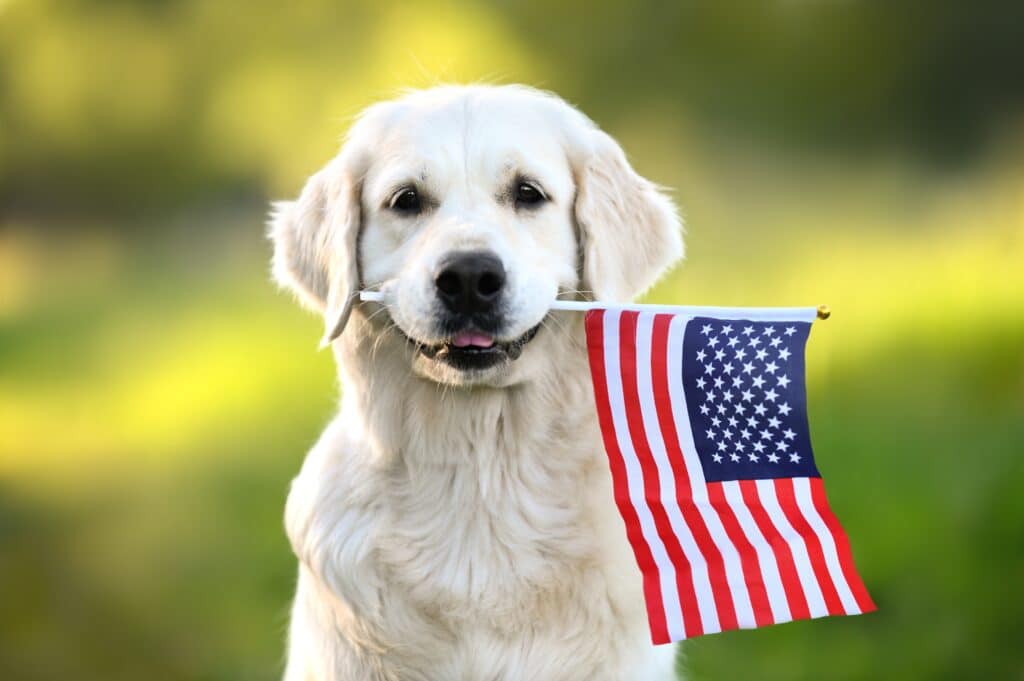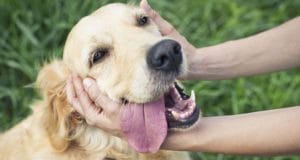In the U.S., states seem to have an incredible fondness for designating “official” things. Some of them are pretty standard, like state flower or motto or song, while others can be unusual. Wyoming has a state dinosaur and Connecticut’s official prepared food is, of course, Mystic Pizza. States can be generic. Milk is the official beverage of twenty of them. If you want an official musical instrument, you have a choice of five options from eight states, with fiddle being the most common.
You’d think that something as popular in America as the dog would be represented in all fifty states, but that isn’t the case. To date, there are only twelve U.S. states that have designated an official state dog. This is still a better score than cat lovers, represented by only Massachusetts and Maryland, by the tabby cat and the calico, respectively.
Here Are the Dozen Official State Dogs, in Order of Designation
Maryland: Chesapeake Bay Retriever (1964)

This breed began with two dogs shipwrecked in Maryland in 1807, although they were never bred with each other. Living on opposite shores of the bay, they were crossed with various local dogs until the breed was designated in 1918 by the American Kennel Club. Part of the retriever, gundog, and sporting groups, they are very active. It’s also the mascot of the University of Maryland, Baltimore County and all of the school’s teams are known as the UMBC Retrievers.
Pennsylvania: Great Dane (1965)

The tallest dog ever recorded was Great Dane Zeus, who stood 44 inches at the shoulder. The breed were originally used as hunting dogs for large game. The connection between the Great Dane and Pennsylvania may not seem obvious, although legislators came up with a long list of reasons in their official declaration, like claiming its head resembles the outline of the state. The most likely reason, though, is that state founder William Penn was a fan of the breed.
Virginia: American Foxhound (1966)

Aptly named, the American foxhound is both uniquely American and uniquely Virginian, having been bred from French foxhounds gifted to George Washington by the Marquis de Lafayette. Energetic and taller than its English cousins, one of the things the breed is known for is its musical howl — which makes it the less than ideal pet for big cities or anywhere else with close neighbors.
Louisiana: Catahoula Leopard Dog (1979)

Originally known as the Catahoula cur and named for a parish in the southeastern part of upper Louisiana, it was redubbed the leopard dog upon becoming the state breed. The dog is not actually named for hunting leopards, though. The name comes from the breed’s distinctive, leopard-like spots. The breed is known for having “glass eyes” — but that doesn’t refer to any vision problem. The breed is prone to heterochromia, in which each eye is a different color from the other, or one or both eyes may have more than one color in it. Traditionally, “glass” refers to blue eyes in dogs.
Massachusetts: Boston Terrier (1979)
This choice of this state dog is probably no surprise, although it is surprising that it took so long for Massachusetts to make it official. The breed was first shown in Boston in 1870. In 1893 it became the first breed originating in the U.S. to be recognized by the AKC. It’s generally believed that all Boston terriers descend from a dog named Judge, who was owned by a Bostonian named Robert C. Hooper. Like many residents of the city to this day, the Boston terrier is quite a sports fan, and excels at many canine agility and sporting events.
South Carolina: Boykin Spaniel (1985)

Not only did the Boykin spaniel become South Carolina’s state dog by being discovered and developed there, but September 1 is Boykin Spaniel Day in the state. The breed originated after a stray spaniel followed a local banker, Alexander White, to church. White gave the dog to his friend and hunting partner Lemuel Boykin, and he developed the breed. Later, breeders began promoting multiple litters per year for the Boykin spaniel, and it is now becoming one of the most common spaniel breeds in the U.S.
Wisconsin: American Water spaniel (1985)

Appropriately, the American water spaniel was developed along the Fox and Wolf rivers in Wisconsin, designed to be a skilled and versatile hunter, compact enough to travel in a small skiff, and able to withstand cold winters in the Badger State. Whether intentional or not, one of the main waterfowl it was bred to hunt is the ruffed grouse — the state bird of Pennsylvania.
North Carolina: Plott Hound (1989)

Originally used for boar-hunting in Germany, this large scent hound descended from wild boar hounds brought to the state in 1750 by Johannes Plott. Despite being one of the older breeds on this list, it was not recognized by the United Kennel Club until 1946, or by the American Kennel Club until 2006. Of the seven coonhound breeds recognized by the UKC, the Plott hound is the only one not descended from the foxhound.
Texas: Blue Lacy (2005)
T his began after the four Lacy brothers moved to Texas, bringing an English shepherd-greyhound-wolf mix with them. This dog and its descendants’ natural herding abilities suited themselves well to working with the Lacy’s free-roaming hogs. Although there was an attempt in 2008 to replace Texas A&M’s traditional collie mascot with a blue Lacy, the collie won out, becoming the sixth consecutive rough collie in the position. (Number eight, Reveille IX, took the position in 2015.) Maybe the Texas state dog will get its turn one day.
his began after the four Lacy brothers moved to Texas, bringing an English shepherd-greyhound-wolf mix with them. This dog and its descendants’ natural herding abilities suited themselves well to working with the Lacy’s free-roaming hogs. Although there was an attempt in 2008 to replace Texas A&M’s traditional collie mascot with a blue Lacy, the collie won out, becoming the sixth consecutive rough collie in the position. (Number eight, Reveille IX, took the position in 2015.) Maybe the Texas state dog will get its turn one day.
New Hampshire: Chinook (2009)

This breed has a somewhat distinguished pedigree, having descended from a mother from the same husky stock as the dogs that went with Admiral Peary to the North Pole and a Mastiff father. The original dog, owned by Arthur Walden, was named Chinook, hence the name of the breed. Fulfilling his destiny, the then 12-year-old Chinook perished on Admiral Byrd’s 1929 Antarctic expedition. The Chinook was the first sled-dog breed brought to New England, where it proved itself very useful through the cold, brutal winters. Unlike the Boykin spaniel, the Chinook is very rare, and wasn’t recognized by the AKC until 2013. Most other kennel clubs do not yet recognize the breed — but that’s probably perfectly all right for the state with the motto “Live Free or Die.” (The breed is so rare that we couldn’t even find a photo of one!)
Alaska: Alaskan Malamute (2010)

Probably the only dog on the list truly native to the Americas, the Alaskan malamute descended from dogs used by the Inupiat of upper Alaska as pack and sled dogs. They are incredibly strong pullers, although slower racers than traditional sledding breeds like huskies. They were also excellent hunters and helped the Inupiat locate seals under the ice by sniffing out their blow-holes. Because they became popular military dogs in World War II, only about thirty registered dogs were left by the mid-1940s, so the breeding registry was opened — but modern Malamutes are still descended from the dogs that were helping the Mahlemut tribe of the Inupiat two to three thousand years ago.
Georgia: Adoptable Dog (2016)

The most recent addition to the list, Georgia’s is also unique. Rather than opting for one breed, the state chose to honor rescue dogs of all kinds. It’s worth noting the reasons given in their original resolution, which apply to shelter dogs in every state: “Thousands of dogs and cats are currently available for adoption in Georgia animal shelters, humane societies, and private rescue groups; Responsible pet ownership that includes spay and neuter of dogs and cats not being actively bred by owners will reduce the number of unwanted dogs and cats that are euthanized in Georgia every year; The State of Georgia wishes to promote responsible stewardship of dogs and cats; and the State of Georgia wishes to promote animal rescue and adoption.”
One last question: What’s the state song of California? If you said “California, Here I Come,” congratulations, you’re wrong. It’s actually called “I Love You California.” If that title sounds familiar, it’s because you’ve heard it countless times in JEEP commercials. But it’s more proof that official state designations are not always intuitive.











